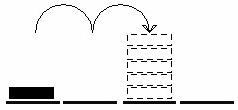 
Prisoner Exchange - Instead of Onboarding or Moving, a player can choose to spend his turn exchanging prisoners. Prisoners are exchanged using the point values of the pieces. A simple value-for-value system is used. Since the pieces range in value from 1 point (for the mute) to 21 points (for the Ace) there are usually several combinations and options available for the players.
The player initiating the exchange selects the pieces he wishes to exchange. These pieces will all add up to some point value. The responding player then has four options depending on the point values of the prisoners that he holds.
Option 1: Give an equal value. If he has a combination of values that exactly equals the value being tendered then he has to either exchange those pieces, or exchange a higher value if he would prefer.
Option 2: Give a greater value. If he has any combination of values higher than the value being tendered he always has the option of exchanging a higher value.
Option 3: Give the next lower value. If he doesn't have an exact match and chooses not to give a higher value, then he must exchange the next value below the value being tendered.
Option 4: Refuse the exchange. If he doesn't have an equal value, doesn't have a lower value, and doesn't wish to exchange a higher value then he can refuse the exchange. If the exchange is
refused then the initiating player can tender a different combination of pieces or make another move.
Hidden information - Hidden information in the game consists of the true nature of the underside of pieces that have been onboarded. The significance of this information is that pieces can be flipped at the start of a move possibly changing the direction they can travel or possibly transforming a blank into a weapon. This information is revealed in the course of the game as pieces are flipped, captured, and onboarded.
The rule that controls what information must be revealed is called the One Hand Rule:
Any manipulations of pieces must be done with one hand in full view of the opponent. For instance, if you onboard a piece inside one of your stacks you must do it in three steps: 1. Take pieces off the top (which displays the nature of the top of the next piece down). 2. Place your onboarded piece on the stack (which reveals the top of that piece). 3. Return the upper pieces to the stack.
Before play begins and throughout the game the players arrange their unplayed pieces such that the opponent can't see them. The game box is used as a shielding wall for this purpose.
You cannot inspect your opponent's pieces except for the ones you have captured. When pieces are captured they can be freely inspected by both players.
General
If a player has no legal moves, then his turn is forfeited. A draw can be called by mutual agreement of the players.
http://www.PlateauGame.com
Copyright © Jim Albea 1986, 2009 All rights reserved.
|
 Black moves first by picking out two of his pieces and placing them in a stack on the perimeter of the board. White does the same on a different perimeter square.
Black moves first by picking out two of his pieces and placing them in a stack on the perimeter of the board. White does the same on a different perimeter square. When a piece has a blue side showing it moves diagonally.
When a piece has a blue side showing it moves diagonally. When a piece has a blank side showing it can move either diagonally or orthogonally.
When a piece has a blank side showing it can move either diagonally or orthogonally. When a piece has a red side showing it moves orthogonally (or straight).
When a piece has a red side showing it moves orthogonally (or straight). When the orange marker is showing the piece moves in a crooked fashion. It moves one square straight and one square diagonally.
When the orange marker is showing the piece moves in a crooked fashion. It moves one square straight and one square diagonally.










 AFTER: White moves three spaces dropping pieces off along the way. On the original square he leaves a blank which continues to pin the black piece.
On the next square he drops-off a weapon which pins that Black piece.
On the next square he drops-off a blank.
AFTER: White moves three spaces dropping pieces off along the way. On the original square he leaves a blank which continues to pin the black piece.
On the next square he drops-off a weapon which pins that Black piece.
On the next square he drops-off a blank.

